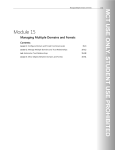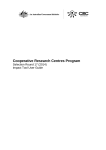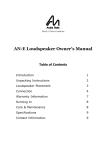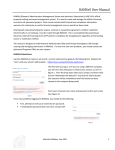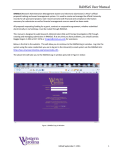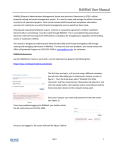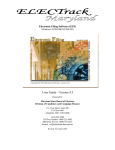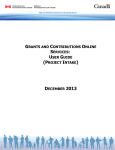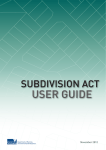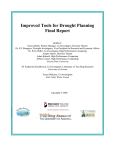Download IMPACT TOOL USER GUIDE
Transcript
IMPACT TOOL USER GUIDE INSTRUCTIONS FOR THE COMPLETION OF THE IMPACT TOOL FOR USE IN APPLICATIONS AND PERFORMANCE REVIEWS Release date: February 2012 BEFORE YOU START … ! How to approach using the Impact Tool To ensure you correctly complete the Impact Tool the way it is intended to be used, please ensure you follow the following approach: 1. Completely read these guidelines – failure to do so may result in an incorrectly completed Impact Tool which, when assessed, could result in a negative impression of the CRC described within. 2. Plan your approach – having read the guidance material prepare a rough plan of how your CRC is to be organised (i.e. how many research programs? how many outputs, usages and impacts? what is the relationship between outputs, usages and impacts?). Only once you have done this should you proceed to the next step. 3. Set up the sheets before entering your data/information – use the set-up macros according to your plan before entering your data/information on each sheet. Due to the inter-dependencies of worksheets across the Impact Tool, it is important that the sheets be set up in the order described in this guide. It is also important that you DO NOT attempt to delete, move, resize or rename any cells, rows, columns or sheets except through the use of the set up macros (buttons). 4. Do not reformat any part of the Impact Tool – the department has set a limit on the number of characters allowed throughout the Impact Tool based on what is visible on screen and in print using the standard settings of the department's computers. If you change any settings, font size, etc, the text may not be visible when received by the department and will be ignored. The only exception to the reformatting prohibition is for CRCs undergoing performance reviews which may colour cells to highlight changes from their original Impact Tool submission. Please clear all cells of advisory messages before entering information. 5. Check your completed Impact Tool – it is prudent to have someone else go over your completed Impact Tool to ensure the information hangs together, is complete and makes sense. It should, when read, tell the story of how the CRC will be/is organised. If your reader is left with any questions, then the selection or review panels will also have questions. Ask the department - if at any stage you are unsure of what to do or what is required, please ask the department for assistance. Contact the CRC Program Phone: (02) 6213-7177 Email: [email protected] Hours of operation: 9 am - 5 pm AEST, Monday - Friday We will respond to your enquiry within one business day 1 Purpose of the Impact Tool The Impact Tool is an important decision support tool used to both forecast and assess Cooperative Research Centre (CRC) performance throughout the life of a CRC. The Impact Tool enables CRCs to articulate the planning they have put into developing and implementing their research programs, including the assumptions made and the risk management strategies proposed or implemented. It also enables the Department of Industry, Innovation, Science, Research and Tertiary Education (the department) and the CRC Committee to test the expectations and assess the performance of a CRC once it is in the CRC Program. The Impact Tool is an important element of the CRC Program’s application process. Applicants should view the Impact Tool as a high level strategic planning tool through which they can identify and make a realistic, transparent and defensible assessment of the intended impacts and benefits of their proposed CRC in a way that is clear, robust and simple to understand. The Impact Tool is also an important element of CRC performance reviews, allowing the performance review panel to assess an active CRC’s progress and to revisit and compare the CRC’s projected future impact with that submitted in its application. Finally, the Impact Tool will also assist the CRC Committee, the performance review panel, the department, and the CRC’s own participants to monitor the CRC’s performance over time. For a comprehensive discussion paper on the rationale behind impact evaluation modelling, and worked examples, the CRC Association developed a 'like' model in 2007. The document explaining the conceptual basis for the model and providing guidance on its application is available from the CRC Association website at: http://www.crca.asn.au/sites/default/files/secure/toolkit/crca_economic_impact_guide_1.pdf A note on the use of this guide While the Impact Tool can be completed by both applicants applying for CRC program funding as well as by existing CRCs being reviewed, the term ‘applicant’ will be used throughout this user guide to describe the person (or persons) completing the Impact Tool when it is not important to differentiate the purpose for completing it. In cases where it is important to differentiate the purpose for completing it to emphasise a particular point, a suitable reference will be made to alert the reader. It is critical to understand when completing the Impact Tool, that the clarity and transparency of the path from input to impact and the quality and rigour of your assumptions are far more important than the final dollar value calculated. It is also important that applicants clearly identify which output(s) underpin each usage and which usage(s) underpin each impact to ensure the pathway is clear to the reader. Information in the Impact Tool should be kept at a high level and will form (or reproduce) the key milestones and outputs of the Commonwealth Agreement. It will also be used to monitor and assess the CRC’s performance over time, including through annual reports and formal reviews. Applicants (and CRCs being reviewed) should only include what they are prepared to be held to in a contract and keep the information factual and measurable. Applicants must support, verify and justify the claims made in the Impact Tool and should reference any claims and assumptions including citing any data sources used. Applicants should not include a ‘sales pitch’ – the Impact Tool is a planning tool not a marketing document. 2 Applicants should use the Impact Tool to put forward a well considered plan. Each input, activity, output, usage, impact and benefit should be treated on its merits and considered individually. Applicants should avoid repetition and ‘cutting and pasting’ of generic milestones between research programs simply to complete the Impact Tool. Excessive cutting and pasting would simply demonstrate a lack of planning. Particular focus should be placed on the risk assessment and risk mitigation strategies. Applicants must undertake a sophisticated risk analysis for each research program and consider ALL factors that may impact on the CRC delivering on its intended outcomes. Applicants must also ensure that risk is correctly and consistently reflected in the probabilities – both the figures and accompanying descriptive text. Proposals that are largely public good in nature can in most instances value the impact of any public good benefit as a monetary value. In cases where this is simply not possible, the Impact Tool allows applicants to describe the impact in non-monetary terms. Public good benefits are a key objective of the CRC program. For a performance review, the updated Impact Tool will provide an indication of how the CRC is progressing on the assumptions and projections made in its successful application bid. In such cases, CRCs are required to revisit the Impact Tool submitted with their application and provide a new, updated version. However, in place of completing the spreadsheet with all forward projections the Impact Tool is to be completed with a mixture of actual figures to date and revised forward projections beyond the current period. The CRC Committee will review the Impact Tool in assessing the merits of CRC proposals and to test the rigour of the thinking and planning put into developing CRC proposal. 3 Framework of the Impact Tool The Impact Tool aims to identify the potential impact of a proposal by articulating the process by which research leads to impacts on the end-user and/or the broader community. The Impact Tool is, therefore, built on the concept that in order to assess the value of research, it must be possible to track the process along a chain, from inputs to impacts. The input to impact chain model involves a systematic grouping of information types. The following diagram is taken from Attachment D of the CRC Program Guidelines and sets out a schematic of the input to impact chain model. The model recognises that what is being measured (and the type of data required) will depend on the life-cycle stage at which it is used (i.e. proposal stage – projected data vs. mid-cycle performance review – real and projected data vs. wind-up stage – real data). The projection of future impacts is not an exact science and ‘value’ can not always be expressed in economic terms. The intent of the Impact Tool is not to generate precise estimates of all CRC costs and benefits, but rather to assist the consideration of the potential costs and benefits in a systematic way and to enable key issues that impact upon the potential projected value to be consistently addressed. 4 Conceptual use of the Impact Tool Acknowledging the challenges associated with impact projection, the Impact Tool does not require CRC applicants to develop a project by project input to impact chain. Rather, it asks applicants to consider the input to impact chain at an aggregated research program by research program level. CRC applicants are not expected to articulate every possible activity, output, usage and impact that they hope to deliver. Rather, for each research program within a proposal, applicants are asked to articulate NO MORE than five key outputs, five key usages of outputs (any usage can involve usage of multiple outputs), and five key impacts that are associated with the usage(s) of output(s). The Impact Tool chain model requires the user to articulate in a transparent way how each step leads to the potential impact, rather than focus on the value of the impact itself. This transparency and clarity is far more important than any estimated ‘value’ of a CRC - more focus should go on articulating the logic underpinning the activity-output-usage-impact plans than on trying to precisely attach economic values to (often non-market) impacts. Users should keep in mind that the overall expected return (with risks fully accounted for) on public funded R&D over a fifteen year time period can be expected to be in the order of $1 $3 of net benefits for every $1 of resources allocated. If applicants present projections of risk adjusted expected net benefit ratios significantly higher than this, then strong evidence would also be expected to support higher returns. Impact Tool Data – Information gathering issues and expectations The first three stages of the Impact Tool – identifying inputs, activities and outputs – are generally an internal process to the CRC applicant, where the information required will be generated by the CRC applicant. Inadequate specification of data at these three stages (e.g. budget, proposal, etc) will disadvantage proposals. At the usage measurement stage, the complexity of data collection is likely to increase due to the potential number of people and organisations involved. Applicants can therefore take a less hardline approach to information gathering to support estimates of usage. It is also likely that there will be factors beyond the CRC’s control (e.g. estimates determined by end-user consultation) that may impact on the rigour of estimates. Impact is also a more complex stage for quantifying verifiable data. In many circumstances, it may be hard to find verifiable and accurate measures for attributing impact (e.g. existing statistical sources such as ABS data, other sector agency data, industry sources and statistics, etc). The identification of intended impact and the best ways of measuring these will have a high degree of uncertainty and imprecision at the CRC proposal stage. This problem is well understood by the CRC Committee and all of the probabilities and cost and benefit valuation numbers provided within the Impact Tool will be viewed within this context. Applicants (and existing CRCs) should therefore note that the assessment of the potential impacts of a proposed CRC will not be primarily based on the numbers presented, but rather will rest far more on an assessment of the rigour and quality of thinking articulated within the application (or other supporting documentation) that underpins the numbers. 5 Technical guidance on the use of the Impact Tool Downloading the template The Impact Tool template is available from the CRC Program’s public website at www.crc.gov.au. The template contains macros that assist with the formatting. Using different Versions of Excel: If you are using a 2003 version of Microsoft Excel you can continue to save the template in the *.xls file format. Depending on your Excel security settings you may be prompted to choose whether or not to ‘Enable Macros’. You should select ‘Enable Macros’ to enable the template to operate. If you are using a 2007 version of Microsoft Excel you will need to save the workbook as a ‘macro enabled workbook’ this means using the *.xlsm file extension rather than the *.xlsx extension. Alternatively you can save the spreadsheet in its original 19972003 compatible *.xls format. Depending on your Excel security settings you may be prompted to choose whether or not to ‘Enable Macros’. You should select ‘Enable Macros’ to enable the template to operate. If you are using Microsoft Excel 2010 it is recommended that you use the version of the Impact Tool developed for Microsoft Excel 2007. The template is not supported by Microsoft Excel for Macintosh 2008, which does not support any Microsoft Visual Basic macros. Once you have selected the version of the Impact Tool to download, the File Download window will display prompting you to Open, Save or Cancel the download of the Impact Tool. To enable the spreadsheet to run successfully, it is recommended that you save the file to your hard drive and open the saved copy. Opening the spreadsheet from within the web browser may cause errors, resulting in the Impact Tool not working correctly. When you are completing the template it is a good idea to SAVE regularly. Setting up the template Before setting up the template applicants should give careful attention to the structure of the information to be entered into the Impact Tool. Each application will likely have a differing number of research programs, and within each research program, different numbers of outputs, usages and impacts. BEFORE commencing work in the Impact Tool template, applicants MUST work out the number of research programs and the different number of outputs, usages and impacts that they will be reporting for each research program. ‘Project Overview’ sheet To commence setting up the template, applicants should click on the ‘Project Overview’ tab. Towards the top of this sheet is a macro button labelled ‘Click to set up template’ (cell reference B12). When applicants click on this button, a prompt will appear asking you to ‘Enter the total number of Research Programs’. Applicants should enter the number of research programs that their CRC will have and then click OK. A new prompt will then appear that asks applicants to ‘enter the name of the first Research Program’. Users should enter the name of the Program (no more than 30 characters) and then click OK. Users will then be prompted to enter the name of the second research program and so forth. Both the research program number and name must be consistent with what has been provided elsewhere to the department (i.e. in CRC Online, etc). 6 The macros will then configure the ‘Project Overview’, ‘Inputs’ and ‘Activities’ sheets of the template. This may take about 30 seconds, after which the ‘Click to set up template’ macro button will disappear and the two macro buttons ‘Add additional research program’ and ‘Remove research program’ which were originally greyed out and disabled will now be visible and functional. The ‘Project Overview’, ‘Inputs’ and ‘Activities’ sheets of the template are now ready to be populated with figures and text. More detail on what data/information to enter on these sheets is provided later in this guide. Preparing the Impact Tool for Performance Reviews – Additional Instructions for existing CRCs only For performance reviews, CRCs are required to revisit the Impact Tool submitted with their application and set up a new updated template (as described for new applications above) which includes both actual figures and revised forward projections. The updated Impact Tool template MUST include the actual inputs received to date, activities conducted, outputs produced, any usage of outputs and associated costs, any progress towards achieving an impact and associated benefits delivered up to 30 June in the year prior to the conduct of the performance review. Revised projections are required for the year of the review and beyond to the end of the period forecast in the Impact Tool (i.e. up to the end of the grant period for inputs, activities and outputs; up to the end of year 12 for usages and year 15 for impacts). The rationale for any changes from the earlier Impact Tool submission must be included in the relevant text. Adding and Removing Research Programs Applicants and CRCs may revise the number of research programs that were created when the Impact Tool template was set up by selecting either the ‘Add additional research program’ button or the ‘Remove research program’ button. To add an additional research program the applicant must select the ‘Add additional research program’ button. They will then be prompted to enter the name of the additional research program they wish to add. To remove a research program simply select the ‘Remove research program’ button and enter the number of the research program that needs to be removed. Note that it is not possible to add or remove multiple research programs in a single operation. The applicant must therefore repeat the operation described in order to add or remove more than one research program. Editing the Name of a Research Program It is also possible to update the name of a research program after the worksheet has been set up without having to remove the existing research program. To edit the name simply select the name of the program in the relevant text box under its ‘Key Inputs’ column (columns B through K, immediately beneath the relevant Research Program number) on the ‘Project Overview’ sheet and re-enter the correct research program name. The worksheet will automatically update the research program name on subsequent sheets in the Impact Tool. 7 Note, you will, however, have to manually correct the name of the research program for the other four columns immediately to the right of the first cell you corrected on the ‘Project Overview’ sheet (i.e. ‘Key Activities’, ‘Key Outputs’, ‘Key Usages’ and ‘Key Impacts’). ‘Outputs’ sheet – instructions for new applicants Before applicants begin completing the ‘Outputs’ sheet of the Impact Tool they need to consider the number of outputs they wish to report against for each research program. It may be useful to map this out visually, as shown in the example below. When applicants are ready to configure the ‘Outputs’ sheet they should select the ‘Click to set up sheet’ button on the top left of the sheet (cell reference G1). They will then be prompted to ‘enter the number of outputs for Research Program 1’. Once this is entered click OK and then enter the number of outputs for research program 2 and so forth. The macro will then configure the ‘Outputs’ sheet and the ‘Click to set up sheet’ button will disappear and the two macro buttons ‘Add additional Output’ and ‘Remove Output’ which were originally greyed out and disabled will now be visible and functional. The ‘Outputs’ sheet is now ready to be populated with figures and text. More detail on what data/information to enter on this sheet is provided later in this guide. ‘Usage’ sheet Setting up the ‘Usage’ sheet follows much the same steps as the ‘Outputs’ sheet. Applicants should consider the number of usages they wish to discuss for each research program before clicking the ‘Click to set up sheet’ button on the top left of the sheet (cell reference G1). Applicants should also consider the relationship between the outputs and usages for each research program, such as shown in the example below. 8 There does not necessarily have to be one usage for each output, as a particular type of usage may require several outputs, (potentially including outputs from across multiple research programs) or conversely a single output may enable multiple usages. Again, it is a wise idea to SAVE the Impact Tool regularly, including before completing this step and after this sheet has been set up. The ‘Usage’ sheet is now ready to be populated with figures and text, including details of which output(s) are required to enable each usage. More detail on what to enter on this sheet is provided later in this guide. ‘Impacts’ sheet Setting up the ‘Impacts’ sheet follows much the same steps as the ‘Outputs’ and ‘Usages’ sheets. Applicants should consider the number of monetary impacts they wish to discuss for each research program before clicking the ‘Click to set up sheet’ button on the top left of the sheet (cell reference H1). Applicants should also consider the relationship between the outputs, usages and impacts for each research program, such as shown in the example below (again, it is acceptable to refer to the interdependency of impacts and usages between the research programs). Sufficient space for describing non-monetary impacts for each research program will be provided once the ‘Click to set up sheet’ button is selected. The ‘Impact’ sheet is now ready to be populated with figures and text, including details of which usage(s) are required to enable each impact. More detail on what to enter on this sheet is provided later in this guide. Changing the number of Outputs, Usages and Impacts As with adding and removing research programs, applicants are able to go back and amend the number of outputs, usages and/or impacts if required after the template has been set up. To add a new output select the ‘Add additional Output’ button and then enter the number of the research program the new output is to be associated with. Click OK and the Impact Tool will then reconfigure itself to include the additional output at the end of the relevant research 9 program. For example to add a fourth output to the current 3 outputs in research program 2, enter 2 in the text field and Output 2.04 will be added to the worksheet. To remove an output select the ‘Remove Output’ button and you will then be prompted to enter the number of the output to be removed. For example to remove output 1 from research program 1 the applicant would enter 1.01 in the text field. Alternatively to remove output 3 under research program 2 the applicant would enter 2.03 after the prompt. The Impact Tool will automatically renumber the remaining outputs. For example if there are four outputs under research program 1 and output 1.03 is deleted, then output 1.04 will be renumbered to 1.03 after the template has reconfigured itself. The process for adding or removing a usage or impact is the same as described for outputs. Note that as in the case of adding and removing research programs it is possible to remove more than one output, usage or impact. However to do this the process must be repeated for each additional output, usage or impact added or removed. Instructions on updating Outputs, Usages and Impacts for the purpose of Performance Reviews – for existing CRCs only Prior to submitting a revised Impact Tool to the department for a performance review, the CRC must review whether any of their outputs, usages and/or impacts identified in their original Impact Tool (submitted along with their CRC grant application) has changed over time and, if so, must revise the relevant figures to reflect the actual and/or new projected values and associated text and colour the relevant cell yellow (to highlight the change). Given space restrictions in the relevant text fields of the Impact Tool worksheet, the CRC must also produce a ‘Performance Review Impact Tool Update’ document for the review panel’s consideration. This document will compare their original Impact Tool to the updated Impact Tool and provide a discussion of any changes, including the rationale for the changes, their implications and any associated risk management strategies. The CRC should clearly address the following considerations against each of the relevant headings (inputs, activities, outputs, usage, impacts, risk analysis, and benefit:cost) in the update document: For the period to date: Did you meet the expectations described in your original Impact Tool submission? What changed? Did it deviate significantly from the original proposal and why? For the period going forward: Have your future projections changed? Clearly summarise what has changed, whether it deviates significantly from the original proposal and why? For any changes noted between the original and updated Impact Tools, provide a clear description and rationale for: o any changes to the probabilities associated with outputs, usage and impact occurring; o the likely scale of costs associated with any changed events occurring; o the likely scale of benefits associated with these changed events occurring; and o the risks and risk management strategies with these changed events or circumstances occurring. 10 Other considerations which CRCs will want to consider include: Are the participants as engaged and committed as originally anticipated? Have all the resources promised been forthcoming? Has the operating environment altered from what was originally anticipated? Has the research and development progressed as anticipated? Has the field of research within which the CRC operates changed significantly over the past three to four years? Have other factors played a role in changing the original expectations presented in the CRC’s application? CRCs should try to follow the input to impact chain rationale when explaining changes (i.e. describe the links between input, output, usage, impact) and how a change in one area will result in a change further down the chain. Specific details should also be provided for any examples presented. Further guidance on completing an Impact Tool for a performance review can be found in the ‘Performance Review Guidelines’ (Attachment B – Updating the Impact Tool for a Performance Review) available from the CRC program website www.crc.gov.au. A copy of the ‘Performance Review Impact Tool Update’ template is available at Attachment B1 of the ‘Performance Review Guidelines’. ‘Benefit Cost Calculator’ sheet The ‘Risk Analysis’ and ‘Additional Information’ sheets do not require any additional steps to set up. The only other sheet that needs to be set up is the ‘Cost Benefit Calculator’ sheet. This can be done any time after the ‘Impacts’ sheet has been set up by selecting the ‘Click to set up sheet’ button at the top of the ‘Cost Benefit Calculator’ sheet. 11 Inputting information The Impact Tool can be populated with both quantitative and qualitative information: Quantitative information Information such as the expected cost of research program inputs or the value of impacts should be entered into the appropriate WHITE cells that initially contain $0 within them. All calculations (contained in the GREY and COLOURED cells) will be completed automatically. Applicants will not be able to type in, or select with the mouse, any non-input cells. When entering numeric data into the ‘dollar’ value cells, please enter a whole number of dollars in each cell and no other information. Do not format this number in any way yourself as these cells will automatically format the whole number entered as a $ figure. The only exception to the reformatting prohibition is for CRCs undergoing performance reviews which may colour cells yellow to highlight changes from their original Impact Tool submission. For years where no ‘dollar’ figure is to be entered, please simply leave the default ($0) in the cells. Figure1 – entering numerical information When entering numeric data in a ‘probability’ cell, please enter a whole number of between 1 and 100 in the white cells initially containing 0%. Do not format this number yourself as a percentage or enter it as a probability between 0 and 1. These cells will automatically format the whole number entered as a percentage figure. Qualitative information All qualitative information will be inputs into text boxes contained in the non-numeric empty white cells in the different sheets of the Impact Tool. The text boxes can not be moved or resized. These text boxes are initially populated with a message requiring applicants not to over populate or reformat the text boxes. Applicants should select these text boxes, delete the initial message and type in them. To prevent overpopulating the text boxes a specific character limit for each one has been set and is noted in the initial message. If the relevant character limit is exceeded applicants will have to remove the excess text before they can proceed. Where more space is required in a text box, the applicant should refer the reader to the additional information tab of the Impact Tool and complete the response there. When using the Additional Information tab, applicants must include a reference back to the text box which is being expanded upon and vice versa so that the reader can follow the conversation. Applicants MUST NOT reformat a text box to incorporate more text, as it will not be possible to view the full response once the application has been printed. Any information provided beyond the visible text WILL NOT be considered by the selection committee. Further, 12 numbers inside the numerical cells must not be resized or reformatted. The only exception to the reformatting prohibition is for CRCs undergoing performance reviews which may colour cells yellow to highlight changes from their original Impact Tool submission. Figure 2 – sample textbox responses A password protection applies to the format of the sheets in the Impact Tool to prevent unauthorised changes. 13 Instructions for completing each sheet of the Impact Tool Specific instructions for ‘Project Overview’ sheet The overview sheet provides a brief presentation of the key elements of each link in the input to impact chain for each research program. A short summary of key points only should be entered into the input, activity, output, usage and impact text boxes for each research program that the CRC is proposing. Applicants may wish to complete this screen last, summarising information in other sheets of the Impact Tool. Specific instructions for ‘Inputs’ sheet For each research program the applicant must enter the total resources (cash and in-kind) allocated to that program by year. All input resources (including research, education, utilisation and administration) must be aggregated as a total annual amount. Resources (cash and in-kind) that do not fit within a specific research program should be allocated proportionally across the research programs included in the Impact Tool. It is, however, a requirement that all resources are captured within the Impact Tool and: (for applicants) the gross total of all programs in the Impact Tool should match the Total Income figure in the Budget Overview of your online application in CRC Online; or (for existing CRCs being reviewed) the annual input figure for each research program in the Impact Tool provided should match the annual income (cash and inkind) reported in your audited financial tables as submitted with your annual reports for the period up to the previous financial year prior to the performance review; and for the current and future years of your CRC grant period the projected annual figures in the Impact Tool should match the budget tables in the most current version of your Commonwealth Agreement. Specific instructions for ‘Activities’ sheet A short dot point summary of key points should be entered into the activity text boxes for each research program. For applicants this information should draw upon the information provided in the applicant’s response to the selection criteria. For existing CRCs being reviewed this information should match the entry in your original Impact Tool submitted with your application or, if any of the activities described have varied since the application, the current version of activities as reflected in the most current version of your Commonwealth Agreement. Please colour any changed cells yellow. These activity descriptions may highlight key activities relating to: research, education, SME engagement and international engagement. Specific instructions for ‘Outputs’ sheet Key outputs should be described for each research program in the appropriate cells. For existing CRCs being reviewed this information should match the entry in your original Impact Tool. Please colour any cells which have changed from your original Impact Tool submission yellow. The outputs should be described in similar terms to those used in the applicant’s response to the selection criteria. The outputs included will depend on the nature of the activities within the research program and may include such things as: publications, patents, trials, products, 14 prototypes, training packages, PhD student commencements and completions, SME or international engagement. Proposed education outputs (i.e. PhD student commencements and completions, etc) should be included within the research program within which the activity occurs. In the ‘Timeline for key milestones cells’, clear, factual and measurable descriptions should be provided for milestones associated with the development and delivery of the output. Specific instructions for ‘Usage’ sheet Key usages should be described for each research program in the appropriate cells. For existing CRCs being reviewed this information should match the entry in your original Impact Tool. Please colour any cells which have changed from your original Impact Tool submission yellow. It must be stressed, that it is not assumed that all of the outputs nominated in the previous sheet will have an associated usage in the time period under consideration (for usage, applicants can comment on usage expected over a 12 year period from CRC establishment) or that a particular usage will relate to just a single output. A single usage may be underpinned by a single output or a number of outputs (from within a single research program or across a number of research programs)1. Figure 3 – Completing the ‘Usage’ sheet Applicants should clearly identify which output(s) underpin each usage by inserting the relevant output number(s) on which this Usage relies (eg: Outputs 1.01 and 1.03) in the text box (at A in Figure 3 above). Identification of usage and quantification of costs of usage Usage refers to the uptake, application or adoption of research outputs by external parties. These may include commercial users, community organisations, Government (for example, through implementation of improved processes or policies), and individuals. 1 In this case, applicants should describe the usage fully in the response section for one of the relevant research programs and then reference this usage again in the response section for the other relevant research program(s). 15 In describing usage, important information to be provided includes: the identity of the planned user of the output(s); the nature of the relationship (if any) between the user and the CRC; the mechanism by which the output(s) will be connected to the user; and the level of effort required by the user to refine/adopt/apply the output(s). Applicants are then expected to provide a discussion and quantification of the scale of usage costs and how this quantification was reached (at B in Figure 3 above). Usage costs refer to the costs incurred to use CRC outputs outside of any costs incurred by the CRC itself (which will have been captured in the CRC input costs sheet). When calculating the costs incurred by the user in using the given output, it is preferable that the end-user or relevant parties involved in the uptake of research outputs provide this figure. It should be noted that in cases where the output user needs to further develop the output and/or market test the output and/or trial the output prior to it being a final output ready for sale/distribution/application, the costs of usage may in fact be significantly higher than the costs incurred by the CRC in producing the original CRC output. It is difficult to predict what may or may not happen in the future and determining usage costs may be difficult. However, there is usually a body of evidence from which applicants may draw upon to support their assumptions. Knowledge of the industry in which the CRC is operating and a strong relationship with your end-users should also assist applicants in determining usage costs with a reasonable degree of certainty. It is fully understood that it is unlikely that CRCs would report usage during the early years of the CRC grant period. It is recognised that there is generally a lag of a number of years between a research program which develops outputs, and the actual adoption or application of these outputs by end-users. This lag is why applicants are able to include usage projected to occur up to 12 years after the commencement of the CRC. In the ‘Timeline of key usage milestone’ cells, clear, factual and measurable descriptions should be provided for key milestones associated with the delivery and progress of each usage. Applicants must also provide an estimate of the monetary costs associated with the key usage milestones and assign costs to appropriate years in the time period under consideration (12 years from CRC commencement)2 in the ‘Estimate of $ costs associated with usage’ section. For years where a cost of usage is anticipated, a whole number of dollars should be entered. Assessment of probabilities on the ‘Usage’ sheet In assessing the probability of all of the required outputs for a particular usage being delivered in a manner that enables usage to proceed (to be included at pO in Figure 3 above), it is important that consideration is given to: 2 the probability of each required output occurring – in considering this issue, applicants should consider both the scientific risk involved and the management risks associated with the operation of a research collaboration; and In the case of a usage that relates to outputs from multiple research programs, the usage cost should be split across the Programs in relation to the relative significance of the outputs from the different Programs to the usage example. 16 whether (to enable usage) it is important that the output is delivered ahead of any alternative solutions being delivered to the same challenge. In many cases, the delivery of a research output (or outputs) will not flow through to usage of the output unless the output is either the first of its kind or the output represents a significant improvement over and above existing competing outputs. This may mean that the probability rating given for outputs being delivered that enable usage may be lower than just the probability that the outputs will be delivered at all. Applicants may need to adjust downward the probability rating to reflect the risk that they may be ‘beaten to the punch’ by a competing output. A description of the rationale used to arrive at the probability selected must be included at C in Figure 3 above. When entering numeric data in the probability cell, please enter a whole number of between 1 and 100. Applicants must also ensure that risk is correctly and consistently reflected in the probabilities (both the figures and text) consistently. The table below provides some generic guidance in relation to what would be considered low, moderate and high probabilities for delivery of output(s) required to enable usage to occur (pO) and also the type of features that would be expected to be linked to a given rating. This table will be used by the department and the CRC committee when considering the probabilities selected in Impact Tool submissions. Probability of output delivery sufficient to enable usage (pO) Probability range Low chance of success 1 –10% Examples of some of the features that may be associated with probability rating CRC applicant can demonstrate only a limited track record of researchers delivering outputs (perhaps because research field is in very early stage of development). High degree of project specific management risk present as CRC participants have not previously collaborated or where the CRC proposes to collaborate with other entities over which it has little influence. Research is in a field where delivery of output "success" is rare. Output would represent a pioneering step change to existing knowledge or situation. Being first to produce output is critical to its usage potential and: share of world research activity - e.g. R&D expenditure, publications or citations - occurring in Australia is low; there are strong known competitors pursuing similar research agenda; and CRC applicants have minimal distinct competitive advantage in this area. 17 Probability of output delivery sufficient to enable usage (pO) Probability range Moderate chance of success 11 – 25% High chance of success 26% + Examples of some of the features that may be associated with probability rating CRC applicant can demonstrate a moderate track record of researchers delivering outputs. Some degree of project specific management risk present but CRC participants do have some record of output delivery through collaborative arrangement. Research is in a field where delivery of output "success" does not routinely occur. Output reflects a significant advance on existing knowledge. Being first to produce output is important but not critical to its usage potential and: share of world research activity - e.g. R&D expenditure, publications or citations - occurring in Australia is moderate; there are some known competitors pursuing similar research agenda but they are less advanced than the CRC applicant; and CRC applicant has some distinct competitive advantage in this area. CRC applicant can demonstrate a strong track record of researchers delivering outputs. Low degree of project specific management risk present as participants have strong track record of effective collaboration. Research is in a field where delivery of output "success" frequently occurs. Output reflects an incremental addition to existing knowledge. Being first to produce output is not of high importance to its usage potential and: Australia dominates activity in this research areas – e.g. it is a uniquely Australian problem being targeted; There are few known competitors pursuing similar research agenda and they are less advanced than the CRC applicant; and CRC applicant has significant distinct competitive advantage in this area. Once the probability of output delivery sufficient to enable usage has been assessed, applicants are then expected to consider the probability of (assuming output delivery has successfully occurred) usage actually occurring (to be included at pU in Figure 3 above). Applicants should insert a figure on a 1 to 100 scale and this figure should assume that output(s) sufficient to enable usage have been successfully delivered. A description of the rationale used to arrive at the probability selected must be included at D in Figure 3 above. The table below provides some generic guidance in relation to what would be considered low, moderate and high probabilities for usage to occur and also the type of features that would be expected to be linked to a given rating. Again, this table will be used by the department and the CRC committee when considering the probabilities selected in Impact Tool submissions. 18 Probability of Usage (pU) Probability range Examples of some of the features that may be associated with probability rating Low chance of success 1 – 25% There are few examples of research outputs in the field that have been adopted by end-users. CRC applicant cannot demonstrate a past track record of its researchers having outputs adopted by end-users. CRC applicant has no past track record of engagement with planned endusers and these end-users have no relationship to the proposed CRC. Distribution channel capability for the proposed outputs is limited and/or new distribution channels will need to be developed and established. Moderate chance of success 26 – 50% While research output usage in the field is not uncommon, it is not standard practice. CRC applicant can demonstrate at least some past track record of its researchers having outputs adopted by end-users. CRC applicant has at least some past track record of engagement with planned end-users and at least some of these end-users have a relationship to the proposed CRC. Distribution channel capability for the proposed outputs is part of the CRC proposal and/or existing distribution channels can be developed for the proposed outputs. High chance of success 51% + Research output usage in the field is common. CRC applicant can demonstrate a substantial past track record of its researchers having outputs adopted by end-users. CRC applicant has a strong some past track record of engagement with planned end-users and at least some of these end-users are core participants of the proposed CRC. Distribution channel capability for the proposed outputs is a strong component of the CRC proposal and/or existing distribution channels can be used and incentives have been factored in to achieve this. Specific instructions for ‘Impacts’ sheet Key impacts should be described for each research program in the appropriate cells. For existing CRCs being reviewed this information should match the entry in your original Impact Tool. Please colour any cells which have changed from your original Impact Tool submission yellow. As with outputs and usages, it is not assumed that all of the usage examples nominated in the previous sheet will have an associated impact in the time period under consideration (for impact, applicants can comment on impacts expected over a fifteen year period from CRC establishment) or that a particular impact will relate to just a single example of usage. For instance, a single impact may be underpinned by a single usage or a number of usages (from within a single research program or across a number of research programs)3. Applicants should clearly identify which usage(s) underpin each impact by inserting the relevant usage number(s) on which this impact relies (eg: Usages 1.02 and 1.03) in the text box (indicated by A in Figure 4 below). 3 It is also possible that impact may rely on concurrent or simultaneous usage examples from multiple research programs. In this case, applicants should describe the impact fully in the response section for one of the relevant research programs and then reference this impact again in the response section for the other relevant research program(s). 19 In the template, applicants are expected to calculate the overall probability that all of the usage(s), required to enable the achievement of a particular impact and described on the usage sheet, will occur (indicated by pI in Figure 4 below). Applicants must then make an assessment of the probability that, assuming required usage(s) have occurred, the impact will be delivered as expected (indicated by pM in Figure 4 below). Applicants must describe how they arrived at each of these probabilities, and any assumptions made (at C and D in Figure 4 below). A full description of how to calculate the overall probability that all of the usage(s), required to enable the achievement of a particular impact will occur (pI) is provided later in this guide. In the ‘Timeline of key impact milestones’ cells, clear, factual and measurable descriptions should be provided for milestones associated with the delivery and progress of each impact. In the template, applicants must provide an estimate of the monetary value that would be associated with a given example of impact and identify who would be expected to reap these benefits4. The monetary value may relate to either public goods (such as improved environmental outcomes to which a value can be attached – e.g. reduced air pollution that in turn leads to lower health costs related to respiratory conditions, which in turn leads to higher rates of workforce participation) or private goods (such as improved commercial outcomes related to sale or use of new products or processes). In the ‘Estimate of $ value associated with impact(s)’ section, for years where an impact is anticipated, a whole number of dollars should be entered into cells as appropriate. In addition to the articulation of the key monetary impacts per research program, applicants must also describe any non-monetary impacts that are expected from each program. Applicants are expected to explain the nature of the impact, who benefits, how important the benefit is, and how probable it is that this non-monetary impact will be delivered. 4 In the case of an impact that relates to usage examples from multiple research programs, the impact value should be split across the Programs in relation to the relative significance of the usage example from the different Programs to the impact delivered. 20 Identification and quantification of monetary impacts Key monetary impact examples should be described for each research program. These monetary impact examples should be briefly described in the appropriate cells. Applicants are also expected to provide a discussion and quantification of the scale of impacts and how this quantification was reached. Estimating the final impact of research is likely to be the most uncertain of the stages in completing the Impact Tool. Impact may include productivity gains, industry development, environmental improvements, health and social benefits, and value from broadening options. These are not always easy to quantify, particularly in dollar terms. You will need to consult with end-users and access existing data sources in order to best quantify impact values. Monetary benefits should, wherever possible, be expressed in terms such as cost reductions for Government, profit increases for business, or increased lifetime consumption possibilities for individuals, as each of these benefits are broadly comparable in that they each increase consumption possibilities. Applicants should assign these benefits to appropriate years in the time period under consideration. The time period allocated for this reporting is 15 years from the first year of CRC funding. Applicants should note that the monetary benefits refer to both valuations for public goods and private goods. Many public goods, particularly in the health, environmental and social outcomes, are of course valued as ends in and of themselves. For instance, lower incidence rates of disease, preservation of biodiversity and improved social cohesion are valued as ‘ends’ in themselves rather than as ‘means’ to an economic end. However, it is often possible to also express (at least in part) such impacts in economic terms. For instance, improved health outcomes often translate to lower health costs and improved workforce participation rates that can be attached a dollar value, preservation of biodiversity can have economic value through enabling sustainable tourism5, improved social cohesion may facilitate lower crime rates and in turn lower costs in the criminal justice system, and so on. Applicants should attempt where possible to present such monetary valuations of impacts that are also ‘valued’ as ends in themselves. Applicants should also note that when quantifying a value of an impact for a beneficiary, it is the ‘net’ benefit rather than the ‘gross’ benefit that should be recorded if access to the benefit involves some additional costs (beyond those already described in the cost of usage rows in the usage sheet) being incurred. For instance, for a patient to benefit from a new medical diagnostic test the patient (or the government on the patients behalf) may need to pay to access the test which means that the net benefit for patients is the value of the gain of better health outcomes minus the cost to the patient of accessing the test. The gross benefit, by contrast, would simply be the value of the health benefits. In this example, the price paid to access the test may itself be a separate impact example, where the producer of the test gains a net benefit of the price received for the test minus the cost to the provider of supplying the test. It is acknowledged that quantifying the final impact of research is the most uncertain of the stages and, again, it must be stressed that it is not the ‘number’ attached to impacts by applicants that will be the primary focus of the selection committee, but rather the quality of the thinking that underpins it. Impact types, which may include productivity gains, industry development, environmental, health and social benefits, reduction of risk of negative events, value from broadening future 5 The OECD in 2002 released ‘Handbook of Biodiversity Valuation: A Guide for Policy Makers’ that applicants may find useful in assessing monetary impacts for biodiversity impacts. 21 options, and so on, are often difficult to quantify. It is also accepted that in a real world situation, few of the impacts you might consider have only one cause, i.e. can be completely attributable to usage(s) of the CRCs output(s). Even if it is possible to identify the other factors or resources involved in a particular impact, it is unlikely that exact quantification will be viable. However, acknowledgement of the issue that other factors will likely contribute to an output, and a transparent attempt to account for it, is important in any impact evaluation and in the dollar value assigned to the CRC. For instance, if the CRC expects to be one of three key contributors to an impact, it should only enter a third of the monetary value of the total net impact when completing the impact sheet of the template. Calculating probability that the usage(s) required to enable impact will occur (pI) For each monetary impact example, applicants are expected to provide a probability that the usage(s) required to enable impact will occur. This figure is calculated by the applicant and is the product of the corresponding probabilities provided on the previous usage sheet (i.e. ‘Probability of usage(s) required to enable impact occurring’ (pI) is the product of the ‘probability that all required output(s) to enable this usage are produced’ (pO) and the ‘probability of usage: given required outputs generated’ (pU)). This figure may differ from the assessment of usage probability set out in the previous usage sheet if the impact relies upon multiple usage(s) occurring simultaneously or concurrently before an end impact is realised. The following summarises the various probabilities required to be entered in the ‘Usage’ and ‘Impacts’ sheets: pO = ‘Probability that all required output(s) to enable this usage are produced’ pU = ‘Probability of usage: given required outputs generated’ pI = ‘Probability of usage(s) required to enable impact occurring’ pM = ‘Probability of monetary impacts occurring (assuming usage(s) has occurred as expected)’ The following worked examples refer to the terms pO, pU, and pI and illustrate how the Probability of usage(s) required to enable impact occurring’ is calculated for a selection of possible outcomes of a research program. If the impact relies upon just one usage (e.g usage 1), then the pI will be a simple multiplication of the corresponding figures detailed in the previous sheet: 1 e.g. pI1 = pO1*pU1 Probability of Impact based on output 1 and usage 1 occurring 22 If the impact relies upon multiple usages occurring (e.g. usages 1 and 2) before an end impact is realised, then the pI is the probability of those usages multiplied: 1 2 e.g. pI1 = (pO1*pU1)*(pO2*pU2) Probability of Impact based on outputs and usages 1 and 2 occurring If Impact 1 is dependent on several usages occurring (e.g. usages 1 and 2 and n) then the formula would be: pI1 = (pO1*pU1)*(pO2*pU2)* (pOn*pUn) In some cases an impact may be dependent on only one of several usages occurring (e.g. usages 1 or 2 or n). The simplest approach for calculating this is to calculate the complement (i.e. the probability that none occur) and subtracting this from one. The formula therefore would be: 1 2e.g. pI1 = 1 – [(1-(pO1*pU1))*(1-(pO2*pU2))*(1-(pOn*pUn))] Probability of Impact based on one of a number of outputs and usages occurring If the impact relies upon a specific combination of usages then a specific combination of the above formulas would be required Note: The ‘Probability of usage(s) required to enable impact occurring’ (pI) can never be greater than 100%. Assessment of probability of monetary impacts occurring (pM) Applicants must then provide a final probability (assuming the required usage(s) have successfully occurred and pI has been calculated) for each monetary impact example. This probability – the ‘Probability of monetary impacts occurring (assuming usage(s) has occurred as expected)’, pM – is the probability that, given the required usages have taken place, the desired impact is realised. This probability relates to the possibility of extraneous factors interposing after the desired usages that prevent final realisation of the desired impact(s). Using the table below, applicants should insert a figure on a 1 to 100 scale to represent pM. Applicants should describe how they arrived at this probability. It should be noted that in many cases, estimating the pM will be substantially more difficult than estimating the other probabilities along the input to impact chain. This is because the majority of extraneous factors influencing delivery of expected impacts are well beyond the control of CRCs, and will often be inherently unpredictable. When assigning a pM applicants should consider how risk factors such as changes in the market for products or processes; exogenous factors such as drought, flood, recession, change of government; changes to consumer preferences or the presence of rival products or processes may reduce or enhance the chance that usage(s) will deliver expected impacts. 23 For non-monetary impacts, applicants are expected to describe each non-monetary impact and then provide, for each non-monetary impact, a probability of it occurring and the rationale for each nominated probability. Again, applicants must also ensure that risk is correctly and consistently reflected in the probabilities (both the figures and text) consistently. The table below provides some generic guidance in relation to what would be considered low, moderate and high probabilities for pM and also the type of features that would be expected to be linked to a given rating. Again, this table will be used by the department and the CRC committee when considering the probabilities selected in Impact Tool submissions. Impact probability (pM) Probability range Examples of some of the features that may be associated with probability rating Low chance of success 1 – 25% The impacts expected from the usage are contingent on low probability exogenous factors occurring. There is a high level of uncertainty about whether the impacts of usage will translate to benefits in the ways envisaged, in ways which can be identified by the CRC, and in a time span which fits into the CRC's monitoring framework. The impact realisation requires that a new product or process (developed as a usage of output) succeed against multiple competing products or processes in a highly competitive market. The planned user of the output, for instance a start-up company, has no track record of delivery of final impacts from their application of research. Moderate chance of success 26 – 50% The impacts expected from the usage are contingent on moderate probability exogenous factors occurring. There is a moderate level of uncertainty about whether the impacts of usage will translate to benefits in the ways envisaged, in ways which can be identified by the CRC, and in a time span which fits into the CRC's monitoring framework. The planned user of the output, has some track record of delivery of final impacts from their application of research. High chance of success 51% + The impact requires only high probability exogenous factors to occur. There is a low level of uncertainty about whether the impacts of usage will translate to benefits in the ways envisaged, in ways which can be identified by the CRC, and in a time span which fits into the CRC's monitoring framework. The planned user of the output has a strong track record of delivery of final impacts from their application of research. Identification of non-monetary impacts In addition to description and quantification of monetary impacts (including the monetary valuation of public goods), in recognition of the often considerable non-monetary impacts that CRCs generate, applicants are expected to provide for each Program a clear description of any such non-monetary impacts they expect to deliver. For instance, a new medical approach that saves lives is valued in non-monetary terms as an ‘end’ in itself as well as for any associated economic benefits that result. Applicants should think in terms of ‘what is valued’ by society as an ‘end’, whether it be better health, social connections, a sense of security, environmental quality and so on when discussing the non-monetary aspects of the impacts that a CRC may generate. 24 Non-monetary impacts may be linked to some monetary impacts or may be completely independent of any monetary impacts. Where the non-monetary impact is related to a previously described monetary impact, the applicant should note this in the response cell. For each research program, space is automatically provided to comment on important nonmonetary impacts and the probability that they will be delivered. For existing CRCs being reviewed this information should match the entry in your original Impact Tool. Please colour any cells which have changed from your original Impact Tool submission yellow. Specific instructions for ‘Risk Analysis’ sheet The risk analysis sheet is a key element of the Impact Tool and is critical in demonstrating the rigour of strategic thinking within the proposed or existing CRC. Applicants must critically examine the potential risks each research program may face and take a structured approach to identifying, evaluating, mitigating and/or managing risk. A number of matrices, frameworks and practices exist that will assist applicants in undertaking a detailed risk analysis and applicants should explore relevant methods to perform a risk analysis for the CRC. Applicants must undertake a sophisticated risk analysis for each research program and consider ALL factors that may impact on the CRC delivering including the risk of the research not achieving the expected results, utilisation not occurring as expected, or delivering the expected impacts; participants withdrawing; project risk; collaboration risk; market risk; and risks associated with exogenous factors. Applicants must detail the key risks along the input to impact chain that could prevent the impact(s) from this program being realised and discuss how they plan to mitigate these risks. Significant focus should be placed on the risk assessment and risks should not be understated. A key factor in the analysis of the Impact Tool will be how well risk has been identified, understood and managed. Applicants must demonstrate that risk has been understood and convince the CRC Committee that all factors have been fully considered. Risk must also be considered, discussed and accurately reflected in the probabilities of usages and impacts occurring and should be at the forefront of thinking when completing the Impact Tool and other components of the application. For existing CRCs being reviewed this information should match the entry in your original Impact Tool. Please colour any cells which have changed from your original Impact Tool submission yellow. Specific instructions for ‘Benefit:Cost’ sheet Once the applicant has selected the ‘Click to set up sheet’ button, the ‘Benefit:Cost’ sheet will automatically self populate the numerical cells by drawing data from all the other previously completed sheets. This summary sheet also provides text boxes for each research program where applicants should enter summary points relating to any non-monetary impacts associated with each research program. 25 This sheet provides a snapshot of the non-monetary impacts for each research program and the monetary benefit:cost ratio of each research program and the overall projected monetary benefit:cost ratio for each CRC. Applicants should note that the figure shown in the monetary benefit:cost calculation is NOT a selection criterion on its own. The selection committee or review panel may wish to sensitivity test assumptions around probabilities and valuations provided in the usage and impact sheets and this calculation sheet will allow for the committee to quickly view how changes to probabilities and cost and benefit valuations would alter benefit: cost ratios. As with all elements of the Impact Tool, it is important for applicants to bear in mind that rather than the numbers presented being the key focus, it will be the quality and rigour of the analysis that underpins the numbers that will be a far more important focus in the selection and review processes. It is well understood, that for a forward estimate of impacts from research, the actual numbers themselves can at best provide a ‘ball park’ estimate and that the numbers will therefore be viewed by the selection committee in this context and also within the context of the nature of non-monetary impacts expected from the CRC. Specific instructions for ‘Additional Information’ sheet This sheet is provided for applicants to use if they feel that the response boxes provided in previous sheets did not allow sufficient space for them to address the topic. The additional information sheet provides up to two additional pages of free text response space for applicants to use if required. Applicants should cross reference material to appropriate places in the proceeding sheets. Also, given that applicants can cross-reference within the Impact Tool to other application or review documents, it is not anticipated that many applicants will need to use all of the space provided in these two additional pages. Other hints Cutting and pasting text into the text boxes. If the applicant is pasting text from another source into the text boxes of the template the text may revert to the Microsoft Excel default text (Calibri, size 11pt). To make the pasted text match the default formatting of the text box click on the clipboard icon that appears next to the pasted text, and then select ‘Keep Text Only’ from the list that appears. The preferred font size for the template is Calibri, size 10pt and Calibri, size 11pt for the Additional Information sheet. 26 Assistance with macros in Microsoft Excel (2007) The Impact Tool macros may not be running due to the macro security settings within Microsoft Excel. To change the settings so that macros can run within the Workbook you will need to follow the instructions below. It is possible for a system administrator to lock the settings. If this is the case you will need to contact your system administrator. It is recommended that you reset the macro security settings once you have run the macros in each of the sheets for the Impact Tool. 1. Click on the Developer tab If the Developer tab is not visible, click on the Office button in the top left hand corner Click on the Excel Options button in the bottom ribbon 27 Tick the box for “Show Developer tab in the Ribbon” Click on the “OK” button 2. In the Developer tab, click on the “Macro Security” button 3. Select “Enable all macros (not recommended; potentially dangerous code can run)” 4. Click the “OK” button 5. The macros for the Impact Tool should now be enabled and run correctly 6. If the macros will still not run download a new copy of the Impact Tool and try again. 28






























